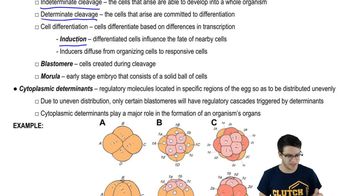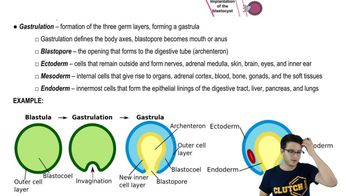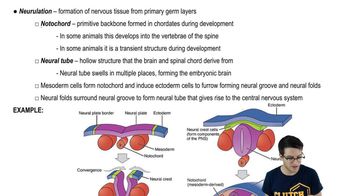Table of contents
- 1. Introduction to Biology2h 42m
- 2. Chemistry3h 40m
- 3. Water1h 26m
- 4. Biomolecules2h 23m
- 5. Cell Components2h 26m
- 6. The Membrane2h 31m
- 7. Energy and Metabolism2h 0m
- 8. Respiration2h 40m
- 9. Photosynthesis2h 49m
- 10. Cell Signaling59m
- 11. Cell Division2h 47m
- 12. Meiosis2h 0m
- 13. Mendelian Genetics4h 44m
- Introduction to Mendel's Experiments7m
- Genotype vs. Phenotype17m
- Punnett Squares13m
- Mendel's Experiments26m
- Mendel's Laws18m
- Monohybrid Crosses19m
- Test Crosses14m
- Dihybrid Crosses20m
- Punnett Square Probability26m
- Incomplete Dominance vs. Codominance20m
- Epistasis7m
- Non-Mendelian Genetics12m
- Pedigrees6m
- Autosomal Inheritance21m
- Sex-Linked Inheritance43m
- X-Inactivation9m
- 14. DNA Synthesis2h 27m
- 15. Gene Expression3h 20m
- 16. Regulation of Expression3h 31m
- Introduction to Regulation of Gene Expression13m
- Prokaryotic Gene Regulation via Operons27m
- The Lac Operon21m
- Glucose's Impact on Lac Operon25m
- The Trp Operon20m
- Review of the Lac Operon & Trp Operon11m
- Introduction to Eukaryotic Gene Regulation9m
- Eukaryotic Chromatin Modifications16m
- Eukaryotic Transcriptional Control22m
- Eukaryotic Post-Transcriptional Regulation28m
- Eukaryotic Post-Translational Regulation13m
- 17. Viruses37m
- 18. Biotechnology2h 58m
- 19. Genomics17m
- 20. Development1h 5m
- 21. Evolution3h 1m
- 22. Evolution of Populations3h 52m
- 23. Speciation1h 37m
- 24. History of Life on Earth2h 6m
- 25. Phylogeny2h 31m
- 26. Prokaryotes4h 59m
- 27. Protists1h 12m
- 28. Plants1h 22m
- 29. Fungi36m
- 30. Overview of Animals34m
- 31. Invertebrates1h 2m
- 32. Vertebrates50m
- 33. Plant Anatomy1h 3m
- 34. Vascular Plant Transport1h 2m
- 35. Soil37m
- 36. Plant Reproduction47m
- 37. Plant Sensation and Response1h 9m
- 38. Animal Form and Function1h 19m
- 39. Digestive System1h 10m
- 40. Circulatory System1h 57m
- 41. Immune System1h 12m
- 42. Osmoregulation and Excretion50m
- 43. Endocrine System1h 4m
- 44. Animal Reproduction1h 2m
- 45. Nervous System1h 55m
- 46. Sensory Systems46m
- 47. Muscle Systems23m
- 48. Ecology3h 11m
- Introduction to Ecology20m
- Biogeography14m
- Earth's Climate Patterns50m
- Introduction to Terrestrial Biomes10m
- Terrestrial Biomes: Near Equator13m
- Terrestrial Biomes: Temperate Regions10m
- Terrestrial Biomes: Northern Regions15m
- Introduction to Aquatic Biomes27m
- Freshwater Aquatic Biomes14m
- Marine Aquatic Biomes13m
- 49. Animal Behavior28m
- 50. Population Ecology3h 41m
- Introduction to Population Ecology28m
- Population Sampling Methods23m
- Life History12m
- Population Demography17m
- Factors Limiting Population Growth14m
- Introduction to Population Growth Models22m
- Linear Population Growth6m
- Exponential Population Growth29m
- Logistic Population Growth32m
- r/K Selection10m
- The Human Population22m
- 51. Community Ecology2h 46m
- Introduction to Community Ecology2m
- Introduction to Community Interactions9m
- Community Interactions: Competition (-/-)38m
- Community Interactions: Exploitation (+/-)23m
- Community Interactions: Mutualism (+/+) & Commensalism (+/0)9m
- Community Structure35m
- Community Dynamics26m
- Geographic Impact on Communities21m
- 52. Ecosystems2h 36m
- 53. Conservation Biology24m
20. Development
Animal Development
Problem 2`
Textbook Question
Which of the following is common to the development of both birds and mammals?
a. Holoblastic cleavage
b. Epiblast and hypoblast
c. Trophoblast
d. Gray crescent
 Verified step by step guidance
Verified step by step guidance1
Begin by understanding the terms related to embryonic development in birds and mammals. These terms are specific stages or structures that occur during the early development of an embryo.
Holoblastic cleavage refers to a type of cleavage where the entire egg is divided into smaller cells. This is common in species with little yolk, such as mammals. However, birds typically undergo meroblastic cleavage due to the presence of a large yolk.
The epiblast and hypoblast are layers formed during the early stages of embryonic development. The epiblast gives rise to the embryo itself, while the hypoblast contributes to the formation of extraembryonic structures. Both birds and mammals have these layers during development.
The trophoblast is a structure that forms part of the placenta in mammals, but it is not present in birds. It is involved in implantation and nutrient exchange between the mother and the developing embryo.
The gray crescent is a feature observed in amphibian development, particularly in frogs, and is not common to birds or mammals. It is involved in establishing the body axis during early development.
 Verified video answer for a similar problem:
Verified video answer for a similar problem:This video solution was recommended by our tutors as helpful for the problem above
Video duration:
1mPlay a video:
Was this helpful?
Key Concepts
Here are the essential concepts you must grasp in order to answer the question correctly.
Holoblastic Cleavage
Holoblastic cleavage refers to a type of embryonic development where the entire egg is divided into smaller cells. This process is common in species with eggs that have little to moderate yolk, such as mammals and some birds. It contrasts with meroblastic cleavage, where only a portion of the egg divides due to a large amount of yolk.
Recommended video:
Guided course

Cleavage and Blastulation
Epiblast and Hypoblast
The epiblast and hypoblast are two layers formed during early embryonic development in amniotes, including birds and mammals. The epiblast gives rise to the embryo proper, while the hypoblast contributes to the formation of extraembryonic structures. This bilaminar disc is crucial for the subsequent formation of the three germ layers through the process of gastrulation.
Recommended video:
Guided course

Fertilization and Implantation
Trophoblast
The trophoblast is a layer of cells forming the outer shell of the blastocyst in mammals, playing a key role in implantation and placenta formation. It facilitates nutrient exchange between the mother and the developing embryo. While crucial in mammals, birds do not form a trophoblast, as their development occurs outside the maternal body in eggs.
Recommended video:
Guided course

Cleavage and Blastulation
Related Videos
Related Practice




























